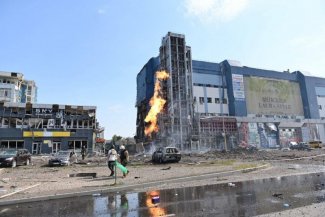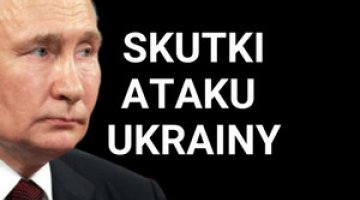Russian air strikes on Kharkiv. Day 922 of the war


Russian forces have advanced to the southern outskirts of Myrnohrad, with only about seven kilometres of open space separating them from Pokrovsk (along the railway line leading from Avdiivka). After seizing smaller towns on their way (Hrodivka and Novohrodivka), the advancing units turned southwards to attack the communication lines of the Ukrainian grouping west of Donetsk.
Under threat of being cut off from their rear, Ukrainian units pulled back from Karlivka and parts of the neighbouring villages, allowing Russian forces to take control of a section of the M04 Donetsk-Dnepr motorway, which has become their main gateway towards Pokrovsk (until now, when attacking westwards, they used the railway line and local roads from Avdiivka). Fighting for Selydove is ongoing. Ukrainian units pulled from the Vuhledar and Kupiansk areas have prevented this town from falling.
It is unknown whether the Ukrainian forces operating in the Krasnohorivka-Nevelske area will decide to withdraw to the west or make an effort to hold their positions as reinforcements arrive. By early September, Russian forces have advanced to within about three kilometres of any supply and withdrawal routes available to the Ukrainian units. These are now exclusively local roads.
Nearly half of the population residing in Pokrovsk was evacuated in mid-August when the operation began. In early September, some 30,000 civilians remained in the city, or 42,000 if we include the residents of the surrounding villages. At the same time, Ukrainian forces have been transforming Pokrovsk into a fortified area.
Russian troops have advanced deeper into Toretsk in two directions and have pressed on with their efforts to outflank Vuhledar. They have cut off the latter city from the nodal town of Vodiane, which lies to the northeast of it, and have also at least partially occupied Prechystivka, which lies to the west of it. All the nodal points on the Marinka-Pavlivka road southwest of Donetsk, which until recently was the main supply route for Vuhledar, have come under Russian control.
Russian forces have been advancing in Chasiv Yar as well as south and north of it: they have occupied further areas adjacent to the Donets-Donbas canal.
They have made further advances in most of the other directions of their operations. South of Orikhiv, they have pushed Ukrainian forces back to the positions they had held before the start of their 2023 summer offensive. Russian troops have also expanded the area under their control south of Velyka Novosilka. The Russian advance southeast of Siversk and Kupiansk has deepened and widened. Russian forces have also reportedly driven Ukrainian defenders from more positions on the border of the Luhansk and Kharkiv Oblasts (near Stelmakhivka).
Ukrainian forces have occupied more areas in the Kursk Oblast, resulting in a relative realignment of the front line. They have made the greatest progress east of the town of Sudzha. However, their attacks on Korenevo have reportedly failed. Ukrainian troops have continued to reinforce the positions they have seized, carrying out more strikes on pontoon crossings across the Seym River in the Glushkovo district: three of the five such crossings built by Russian forces have reportedly been destroyed. According to the Ukrainian operational-tactical group of troops ‘Kharkiv’, more subunits from the Leningrad Military District are being moved to the Kursk Oblast.
August was the most active month for both sides in over a year. As many as 145 clashes per day were recorded on average, according to data from the Ukrainian analytical group DeepState. According to the General Staff of the Armed Forces of Ukraine, a record 215 clashes took place on 29 August – twice as many as on the most active days in the war’s previous periods. When we take into account the realignment of the front line in the Kursk Oblast, Ukrainian forces captured more than 950 sq km of Russian territory in August. Russian advances, though significantly smaller, can be assessed as the most significant for the ongoing operations. In August, Russian troops reportedly occupied (depending on sources) between nearly 370 sq km and over 428 sq km. Almost two-thirds of their gains (at least 227 sq km) came in the Pokrovsk direction.

Russian air strikes have targeted Kharkiv continuously since 30 August. On that day, one of their guided aerial bombs hit an apartment building, killing six people and injuring 99. The scale of the tragedy is demonstrated by the fact that a total of 147 people were injured in the eleven air strikes that targeted the city in August. A further 50 civilians were injured in an attack on 1 September. In total, Kharkiv was hit by dozens of rockets, drones and guided aerial bombs that damaged targets including energy infrastructure.
Sumy and its surroundings (29, 31 August and 1 September) as well as Poltava and the Poltava Oblast were attacked less frequently (strikes on targets including industrial facilities were reported on 30 August, 2 and 3 September). Russian missiles fell on Kyiv, Dnipro and Zaporizhzhia on 2 September, Odesa on 29 August and Kryvyi Rih the day before. On 29 August, the Belarusian air force for the first time shot down a Russian kamikaze drone that flew into the Belarusian airspace from Ukraine. Between 28 August and the morning of 3 September, Russia reportedly used a total of 86 missiles and 213 attack drones. Ukrainian forces claimed to have destroyed 29 and 151 of these respectively.

On 1 September, Ukraine carried out its largest ever attack on Russian territory. Russia claimed to have destroyed 158 kamikaze drones over 16 regions and the capital Moscow. The largest number of these (46) were reportedly downed over the Kursk Oblast. The attack set off fires at the Kapotnya refinery and the Konakovo power plant in the Tver Oblast; the former facility partially halted production but no major damage was reported at the latter. Reports that a drone struck a power plant in Kashir in the Moscow Oblast have not been confirmed.
Drone attacks on Crimea, the Russian border regions (30 August) and an airfield in Tver (3 September) were unsuccessful. In the evening of 3 September, Ukrainian forces carried out an air attack on Belgorod in what Ukrainian media described as revenge for an earlier attack on Kharkiv. According to local sources, five civilians were killed and 37 were wounded.
On 28 August, Ukrainian drones struck more Rosreserve facilities, triggering a four-day fire at the Atlas fuel depot in Kamensk-Shakhtinsky in the Rostov Oblast. Satellite images have confirmed that it engulfed at least three tanks with petroleum products. However, an attack on a fuel depot in Kotelnich in the Kirov Oblast largely failed. On 2 September, a fire at the Rosreserve fuel depot in Proletarsk in the Rostov Oblast was extinguished after 16 days. More than 30 tanks with a capacity of up to 500 m3 burned in that fire.

The Netherlands has decided to supply Ukraine with 28 Bandvagn BvS10 Viking tracked articulated armoured personnel carriers. Training on these vehicles began back in the spring of 2023. On 28 August, the Lithuanian Ministry of Defence announced a new support package, which includes anti-drone systems and logistical and medical equipment. The Romanian government is formally preparing to transfer a Patriot system to Ukraine. The Senate approved the relevant government bill on 2 September; the Chamber of Deputies is expected to vote on it by the end of the week.
On 30 August, the Ukrainian office of the German company Quantum-Systems announced that it had launched a plant in Ukraine to assemble Vector reconnaissance drones using kits supplied from Germany. The facility was opened last spring and is currently introducing Ukrainian-made components (wings and satellite signal receiving antennas) into the drones it is assembling. In the longer run, there are plans to expand the plant’s operations to include the production of fuselages.
On 30 August, the EU High Representative for Foreign and Security Policy, Josep Borrell, announced that Ukraine had so far received 700,000 artillery shells out of the one million promised. Under the original plan, one million shells should have been handed over by March 2024. A day later, Borrell announced that the number of Ukrainian servicemen to be trained by the EUMAM mission by the end of this year would be increased by 15,000. The defence ministers of the EU’s member states had reached an agreement to this effect on 31 August. To date, EUMAM has trained 60,000 Ukrainian troops.

On 29 August, Alyaksandr Lukashenka said that he would never order an attack on “anyone” and would not agree for the country’s armed forces to be used outside Belarus. On the same day, Ukrainian State Border Service spokesman Andriy Demchenko said that Ukrainian forces were in full control of the country’s border with Belarus – from Volhynia to Chernihiv Oblast. He added that no unusual situations indicating the movement of Belarusian units near the border line had been reported and that Belarusian troops were dozens of kilometres from the border with Ukraine, with intelligence units actively monitoring Belarusian military activity.
On 29 August, in comments to the Russian independent TV channel Dozhd, Indian MP Vikramjit Singh Sahney stated that the Russian military had recruited more than 90 Indian nationals by deception (offering attractive employment) to fight on the Ukrainian battlefront. At least eight of them have been killed while several escaped.

On 30 August, President Volodymyr Zelensky dismissed the commander of the Air Force, General Mykola Oleshchuk. General Anatoly Krivonozhko, the former head of the Air Command ‘Center’, temporarily took over his duties. The decision was preceded by reports that an F-16 fighter jet and its pilot had been lost, which reportedly occurred during a Russian missile attack on 26 August. The aircraft’s loss was revealed by US media outlets, which suggested that the pilot’s error had likely caused the crash.
On 2 September, the Commissioner for Human Rights, Dmytro Lubinets, said that since the beginning of the year, more than 1,600 complaints about violations of civil rights by employees of military commissions had been lodged with his office. In 2023, there were only 561 such complaints. This demonstrates the growing public dissatisfaction with the efforts by military commissions to carry out mobilisation at all costs, including by handing out draft notices outside their offices.
Also on 2 September, the Ukrainian parliament’s budget committee voted in favour of a law that increases defence spending by 500 billion hryvnias (over $12 billion). These funds should be used to cover shortfalls in the armed forces.

On 29 August, Ukraine’s Prosecutor General Andriy Kostin reported that Odesa Oblast accounts for the largest number of illegal border crossings by those evading military service. He acknowledged that the country’s border service had insufficient resources to ensure full control of the border. On 2 September, the service reported that more than 570 criminal groups organising illegal border crossings had been dismantled since 2022, including more than 200 since the beginning of this year alone.
On 30 August, Ukrainian Deputy Minister of Internal Affairs, Bohdan Drapatyi, suggested that the country’s population may own up to five million undeclared weapons and that this situation could be normalised to some extent when a law granting civilians the right to legalise their firearms comes into force in November.





